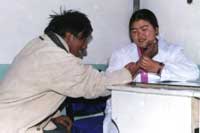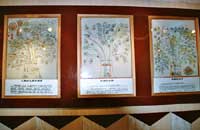| Tibetan Medicine |
|
SCOTTISH
PROJECTS THE
HERITAGE PROJECT IN TIBET TIBETAN
HERITAGE
|
|
|
|
|
|
|
The
medical world can be split into two basic categories the direct
diagnostic approach and that of technology based observation, Traditional
Tibetan Medicine (TTM) lies within the former category. The knowledge
behind Tibetan Medicine has been practised and developed for over
2500 years. In the 7th century the first Youtok Yonten Gonpo,
the greatest physician of Tibet who had studied extensively the
essence of Chinese and Ayurvidic medicine, wrote the first medical
texts on Tibetan Medicine, known as the "Four Tantras".
The
four Tantras explain how the body is formed, and how it functions
right down to the smallest cells in relationship with the five elements
and also how it deteriorates, how to prevent disease and how to
cure aliments . The
Five Elements The Indian system, in which they apear primarily as the 5 fundamental components of all relative phenomena, corresponding to what, on one level, we would currently call matter, bonding, thermodynamics, kinesis and space. The Chinese system, in which they appear in a more dynamic sense, corresponding to four general phases of all life cycles and an underlying ground state, i.e. initial growth, maturation, decomposition and resorption into the whole, that is taking place on all sorts of levels and over all sorts of timescales, from the molecular right up to the duration of a human life. These two systems are not contradictory but complementary. Both are employed extensively in Tibetan medicine. Pulse palpation, for instance, is very much concerned with attuning to the immediate state of the body and so uses the dynamic form of the elements. The pharmaceutical theory of TTM however is more concerned with the more constant therapeutic properties of its materia medica, and hence resorts more to the compositional aspects of the 5 elements. Helping
to Preserve Traditional Tibetan Medicine :TTM
in the West -
Maintaining
high standards
|





